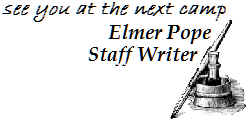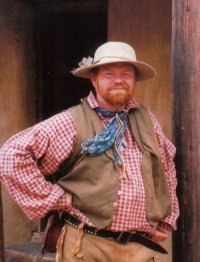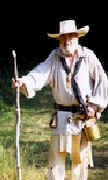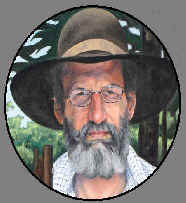________________________________________
An
American
Fort on the Souris River
(Approximately
1810 - 1828)
The
American Fur Trading Company incorporated in 1808 with the
intention of operating on the Souris River. They claimed
that the river was below the as-yet unmarked border between
Canada and the United States.
In
1934 a Métis old-timer by the name of Antoine Gladu
disclosed the existence of the site of an old fort on the
north bank of the Souris River, directly north of Lauder. It
was probably built by the American Fur Company, one of two
that they built on the Souris River. The year 1810 is a good
estimate for when it was constructed as the clay chinking in
the chimney dates after Ash House (constructed by the North
West Company in 1795) but before Joseph Desjarlais built his
large and successful independent fort in 1836. As far as
Souris River fur trading posts go, this American Fort seems
to have been operational for a decently long time, though
less than 20 years.
|
First
Fort
Ash
House (Fort de la Frèniere, Fort of the Ash, Ash Fort or
Fort Ash) was likely the first fur trading post built along
the Souris River. At the time of its construction there was
fierce competition among five fur trading posts, all
operating in close proximity to one another near the
confluence of the Souris and Assiniboine Rivers. Ash House,
built in 1795, appeared just two years after the first of
the Assiniboine River posts started trading. It was an
attempt by the North West Company (NWCo) to gain further
profit by drawing on the growing Souris basin trade, and
more specifically to meet the competition of the company’s
major rival, the Hudson’s Bay Company (HBC).
Location
Ash
House was built on the north shore of the Souris as a canoe
fort. The Souris River surrounded it on three sides, and in
wet years a depression to the north of the fort also filled
with water, making it approachable only by canoe. The Yellow
Quill trail still faintly discernible today runs
parallel to the Souris. For a fort dealing with trade,
gaining proximity to this avenue of land travel and
transport would have been a shrewd strategy. Also, in the
vicinity of Ash House was a sand hill that may have been
used as a lookout.
Abandoned
Ash
House only operated for a year or at most a year and a half.
This is possibly due to the fort’s vulnerability to
attack. From about 1748 onward the Dakota were known to wage
war on anyone trading on the Souris River to discourage
foreigners from establishing control over trade in the area.
More probably, Ash House was abandoned because of poor
management or strong competition. It just wasn't profitable.
In any case, when the explorer David Thompson passed through
the area in December of 1797, he camped a few miles away and
reported that the fort was abandoned.
|
A
portion of the fort has been eroded by the Souris River, but
from what remains, the size of the fort is estimated to have
been 100 feet by 120. The remains of cellar holes and
chimney mounds indicate that three buildings were enclosed
by an outer stockade.
The
American Fort's closing around 1828 was most likely due to
Cuthbert Grant's appearance on the Souris River. Grant acquired
the authoritative title of “Warden of the Plains”
(questionable in his methods) and instructions from the HBC
to rid the Souris River of independent and American fur
traders (again questionable orders).
A
charcoal line ten inches deep in the river bank provides
evidence that the fort burned down in the end. It's not
likely that Grant burned it, as he would have been content
enough to see the traders go but leave the building itself
in one piece. Old timers of the district report that the
building remained standing for a time after it was no longer
in use. It is more likely that the fort was burned down by
Dakota or was the victim of a prairie fire.
Just
thought you would like to know that not all ventures panned
out.
Thanks
to several sources that provided bits and pieces of
information on this old location found here on the
Internet.

I'm
the original Elmer (damnit)...
__________________________________________
We
are keeping a page OPEN for one of several writers we
have used in the past. Here at the North American
Frontiersmen Association On-Line Journal Office (My Place)
we get several emails monthly asking for more work from:
Michael
Moore, Randy Bublitz, John Kramer, James Keller, Jim Harsh, Elmer Pope
and several others used in past issues.
|

MIKE
MOORE
|

RANDY
BUBLITZ
|

JOHN
KRAMER
|
|

JAMES
KELLER
|

JIM
HARSH
|
WHY
NOT ADD YOUR NAME TO THE LIST?
|